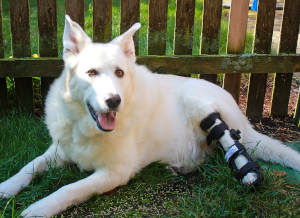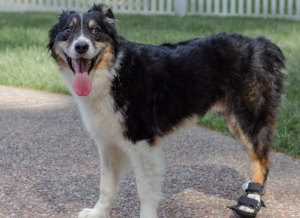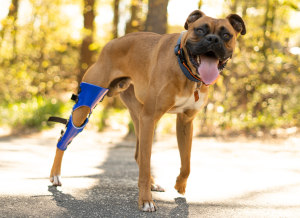What is the Correct Rear Splint for My Dog?
By admin / April 28, 2023 / No Comments / Uncategorized
If you notice your dog’s rear legs going out, giving them pain, or showing signs of injury or lameness, you must go to your vet as soon as symptoms appear. This way, they can make sure your dog’s condition is not severe, and if it is serious, they can take care of your dog’s needs from there. Once they have advised you of your dog’s condition and the cause of their issue, you can then determine the steps needed to help your dog out. Proper treatment may include medication, surgery, a supportive harness, or even a splint to support and stabilize the leg. Finding the correct splint for your pet based on their injuries and diagnosis is a great way to help them on the path of healing correctly.
Choosing the Right Rear Splint
Once you have discovered the root cause of your dog’s issues, your vet will advise you on what needs to be done to assist them further. If your dog still has mobility and the ability to use its injured leg, your veterinarian may advise you to get a splint for your dog’s injured leg. While this is a great start, many kinds of splints can be used to support your pup, and finding the one most suited to helping their injury can help make the healing process and the process of assisting your pet in acclimating to the new brace.
Before you order a hind leg splint for your pet, you must know the following:
- Where is the injury on the hind leg?
- What joints need to be supported?
- Does your dog’s back paw need to be braced?
- How long will your dog need to wear the splint?
Knowing the answer to all of these questions, will help you make the best rear splint choice for your dog.
Rear Splint

While splints are made for specific areas of the leg, the most general splint your pet may need for a rear leg would be something to encompass the entirety of the lower hind leg. A rear leg brace will support the dog from the toe, under the paw, and above the hock. This will assist in protecting the paw itself and keeping the hock joint and everything that runs between the two.
These splints are good for fractures, breaks, and sprains in the lower leg and can help give extra support to dogs with minor weakness. These are designed specifically for the lower leg and will not support the knee. Adjustable versions of these splints can be found, and custom versions.
Hock Splint for Tarsal Support

A Hock Splint is designed to support the hock joint and provide extra reinforcement above and below the joint itself. These are great splints for lower leg injuries that do not involve the paw. As it does not have the foot encased in a boot, these splints are great options for dogs who don’t like their paws touched, and the subtraction of the paw potion of the boot helps to make these splints even more lightweight for a recovering dog.
There are custom hock braces available as well as off-the-shelf versions. An off-the-shelf hock brace is the best option when dealing with a short-term injury that will take a few months to heal. A custom leg brace is best suited to dogs with a longer recovery or a unique diagnosis that requires bracing.
Bootie Splint for Back Paw and Ankle Injuries

On the opposite end of the Hock Splint is a Bootie Splint. A bootie splint is designed only to assist the lower portion of the leg. This style of brace supports the paw and ankle or wrist. These splints will not help the hock joint or any point higher up on the rear leg.
Splints like these are great for breaks in the foot or dogs who are starting to lose their footing. Issues like knuckling and dragging are common reasons for a dog to need a Bootie Splint. The shorter splint style is ideal for dogs dealing with temporary toe or paw injuries.
Knee Splint

A knee brace is designed only to support the knee. By bracing the knee, a dog will experience joint pain relief, stifle joint support, and reduced joint inflammation. Custom bracing can be expensive and will take time to be fabricated. If your dog has an ACL or CCL tear or injury to the knee, this is the best bet. These are usually custom-made as they need to naturally move and flow with your dog’s movements and allow the knee to be still used without causing extra strain on the stifle joint.
A rear wheelchair can be an alternative for a dog knee brace. A wheelchair’s support reduced the strain and weight bearing on the hind legs to allow continued activity as the injured leg heals. Only use a wheelchair if it’s safe for your dog to be active, talk to your veterinarian first.
The Right Fit is Important
For your dog’s safety and comfort, it’s critical that their splint fit them properly. Always measure your dog’s leg before you buy your splint. Every dog is unique, and the splint should fit snuggly, but comfortable. Watch the video below to learn how you measure your pet’s back leg for a brace.
Conclusion
While there are many kinds of back leg injuries and splints to assist them. Knowing where your dog’s injury is, and the type of leg support they require is a great way to help your dog heal. Pre-made splints and completely custom-made are all great options, but the most important thing to figure out is what type of splint your dog needs. From that point on, you can decide the best choice for your dog.
When selecting a dog splint, always consider your dog’s medical needs and preferences. Whether your dog is sensitive to having their feet touched or you’re concerned that having too much additional weight on their leg, finding the right splint will help make their healing time and the whole process simpler for you both!
